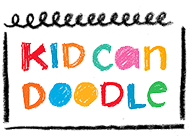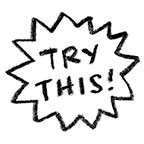
Today we’re debuting a new feature called Awesome Artists. In this column, we aim to examine artists’ works and see if we can learn from their techniques, process, or expertise.
Meet Awesome Artist Kirsten Ulve
It’s such a pleasure to start this terrific series with someone whose work I’ve always admired: Kirsten Ulve. A renowned illustrator who specializes in creating caricatures, Kirsten works in a digital medium using Adobe Illustrator and Photoshop. Her stylized work has appeared in countless publications including The New Yorker, Glamour, Entertainment Weekly, and InStyle.
I marvel at her ability to capture the essence of someone in her unique voice — and she was gracious to grant us an interview! Kirsten not only shares her creative process, but her pencil sketches (which she would propose to a client before doing a final colored rendition) too.

See if you can guess who is depicted in the drawings!
KCD: Do you try a few different sketches, trying to see how much you can stylize someone?
KU: No, I just start sketching and see where it goes. For me, there is usually only one answer when doing caricature: it either looks like the person, or it doesn’t! Sometimes I simplify the drawing when it goes to color.
 Her stylized approach reminds me of Cubism. The way the physical features seem to “sit” on different planes, as if there are multiple viewpoints instead of one perspective is common in Cubist paintings. The sharp angles with contrasting curvy swirls mimic the fragmented look seen in works by “Les Demoiselles D’Avignon” (1907) by Pablo Picasso or “Woman with a Mandolin” (1910) by Georges Braque.
Her stylized approach reminds me of Cubism. The way the physical features seem to “sit” on different planes, as if there are multiple viewpoints instead of one perspective is common in Cubist paintings. The sharp angles with contrasting curvy swirls mimic the fragmented look seen in works by “Les Demoiselles D’Avignon” (1907) by Pablo Picasso or “Woman with a Mandolin” (1910) by Georges Braque.
What do you look for when you draw someone?
I always start with the eyes and try to capture the feeling there, or the personality the person usually shows to the public (or portrays in a movie if the caricature is about that). It helps to look at video of the person speaking so I can see how their mouth moves, or how much their teeth show when they’re speaking, or how far their nose sticks out. A lot of pictures are taken head on, so it’s hard to see how big noses are. Then I look at the distances between features on the face.

There’s a geometric quality to her characters. Can you see circular or triangular shapes or parallelograms in her drawings?
Who/what types of faces(?) was/are the hardest person to draw? And why?
I can never predict who’s going to be hard or easy to draw. It just depends on what mood I’m in. I can’t do it if I’m tired or angry. It’s like I just start drawing and they just eventually appear. But in the past, the people that took me forever to get right were Sara Jessica Parker and Bradley Cooper! I think the reason is because I was focusing too much on one feature instead of capturing the whole face, which I always try to do.

Don’t you love that she’s audacious enough to color someone purple?
For most people, drawing a face is the most difficult; it’s hard to capture the likeness well. It seems amazing to me that you so confidently capture their likeness, while infusing your own voice. Is there any insight you can impart to all of us who are learning to do that?
For me, it makes it so much easier to draw someone if you’re familiar with the way they act (this is why I like to use video). Also, it really helps if you can try to “be” that person a little bit while you’re drawing. Go ahead and try to imitate them! It helps me get their expressions right. I try not to work from one photo. It’s good to have a variety of pics at different angles with different expressions. This way you can get a feeling of how someone moves their face. It’s hard to work from normal, smiling photos. A person’s unique look comes out more when you can see them being themselves.
***
It’s interesting to learn that Kirsten prefers to use videos for drawing reference instead of photographs. Whenever possible, it’s better to draw things that we can see three-dimensionally, rather than a 2D image. I think it often feels more lively when we do. Sometimes a photograph can distort information we see, depending on light and perspective, and be misleading when we try to copy it. (Not a perfect example, but remember that viral blue and gold dress?)
Let’s conduct an experiment! Ask a sibling or friend to let you draw them for 10 minutes. Then take a photo of them in a similar pose, and use that image as reference to draw them. Do you notice a difference? Is there an improvement in your drawing or does one portrait feel more authentic than the other?
Thanks again for sharing your work with us Kirsten! See more of her fabulous work here or purchase her art here.
All images courtesy of Kirsten Ulve.












